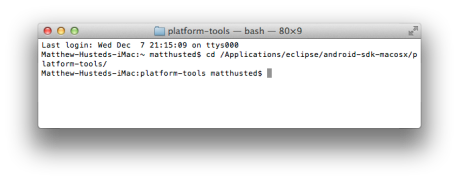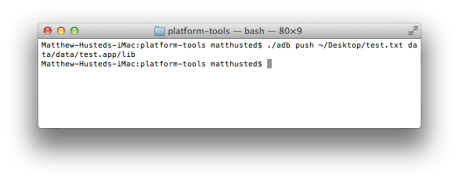The Android Debug Bridge (ADB) is a command line program that helps developers communicate with usb connected android devices or emulators. The ADB is a good way to install/uninstall apps and access the files on your device. Since the ADB comes bundled with the Android SDK, it should be located in the Android-SDK folder on your computer.
Depending on the OS you are using, the Android-SDK folder will be named either android-sdk-macosx, android-sdk-linux, or android-sdk-windows.
The path is: /<path to sdk folder>/android-sdk-<platform you are on>/platorm-tools/
For all commands on windows the “./” is not needed.
An example path is shown below, where /Applications/eclipse/ is the folder location and macosx is the platform.

ADB devices is a way to view a list of the currently attached devices both usb connected and emulators.
$ ./adb devices

ADB shell allows shell access to a usb connected device or emulator with similar functionality of the shell on your computer.
$ ./adb shell

ADB push allows you to move files or directories from your local machine to a usb connected device or emulator.
$ ./adb push <file location on local machine> <destination on device>

ADB pull allows you to move files or directories from a usb connected device or emulator to your local machine.
$ ./adb pull <file location on device> <destination on local machine>

ADB install allows you to install an apk to a usb connected device or emulator.
$ ./adb install <apk location on local machine>

ADB uninstall allows you to uninstall an app on a usb connected device or emulator.
$ ./adb uninstall <name of package you want to uninstall>

These are just a few of the many functions of the ADB. For a complete list you can use the “adb help” command to print all commands to the screen.
This post is also located on the FSU Mobile Lab Website!






